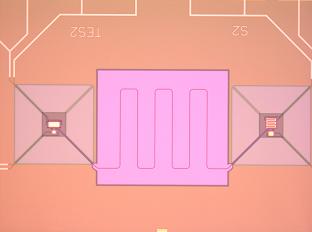Lab-on-a-chip to develop the ultra-low-noise detectors used for the next generation of astronomical space-borne observatories, such as SPICA. The device of the left is a ultra-low-noise TES detector on a suspended SiNx membrane; the device in the centre is a meandering superconducting transmission line; the device on the right is a blackbody load, with thin-film resistor for radiometric thermometry at 100mK. The whole device measure just 2x1mm.
The Quantum Sensors Group is involved in the development of a range of detector technologies: including millimetre-wave and submillimetre-wave Transition Edge Sensors for ground-based astrophysics---in particular polarimetry of the Cosmic Microwave Background Radiation; Kinetic Inductance Detectors for far-infrared wavelengths---in particular SPICA, an ESA far-infrared space observatory; Superconducting Quantum Mixers for ground-based high-resolution spectroscopy, and interferometry of the Sunyaev-Zeldovich effect in distant clusters of galaxies; Cold Electron Bolometers for near-quantum limited detection at submillimetre wavelengths. SQUID readout and multiplexing for large arrays.
A major project is to construct a number of large-format polarimatric imaging arrays for the frequency range 100-300GHz; these will be used on CLOVER, an instrument being developed in collaboration with the Universities of Cardiff, Oxford, and Manchester, to search for gravity waves in the early Universe through a signature in the polarisation state of the CMB.
The second picture on the right shows one of the ultra-sensitive superconducting TES detectors developed for CLOVER. These are designed for 100-300GHz, operate at 80mK, and represent some of the most sensitive detectors available internationally. Over 1000 of these detectors will be needed for the final instrument.
To underpin the development of ultra-low-noise detector technology, the Group has many programmes in areas such as measuring heat transport in low-dimensional structures, studying noise mechanisms in superconducting films and resonators, understanding the optical physics of partially coherent millimetre and submillimetre-wave instruments and devices.


